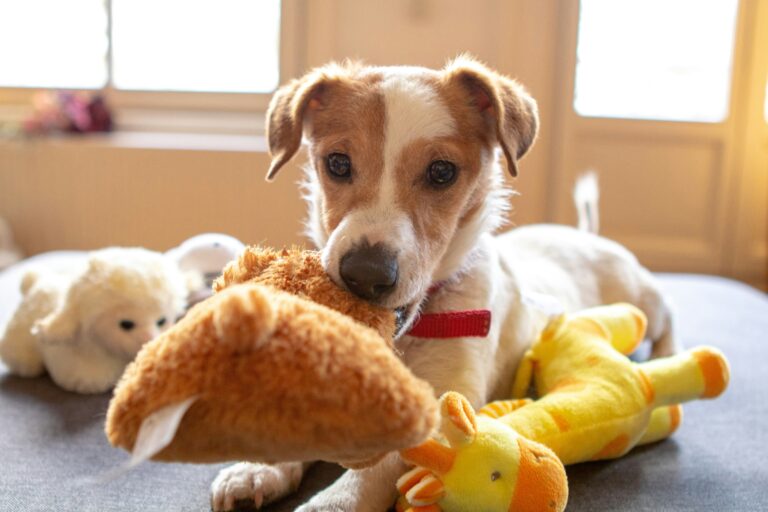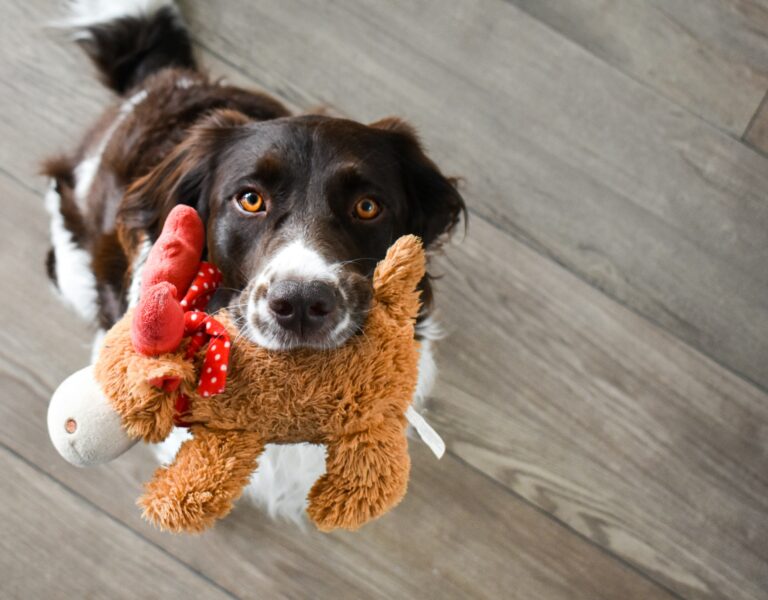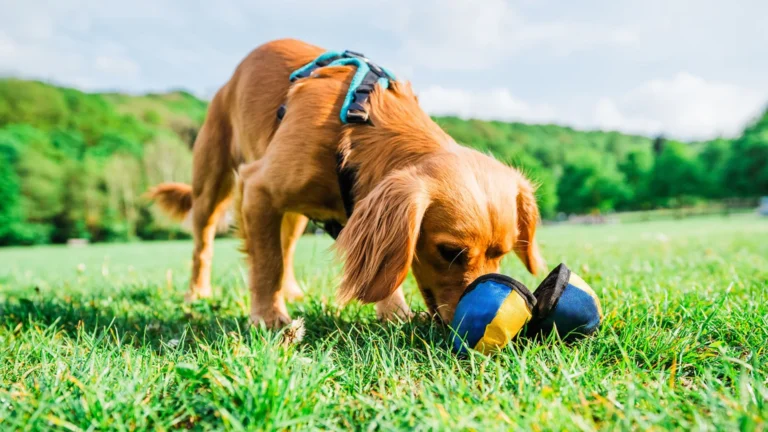In the realm of dog toys, the struggle is real for our smaller, four-legged companions. Their tiny jaws need something just as fun, engaging, and durable as the toys designed for their larger counterparts, but appropriately sized. Fret not! This piece will shine a light on “Pint-Sized Pup Playtime: The Best Tug Toys for Small Mouths,” where we’ll delve deep into the world of pet toys designed especially for our smaller canine buddies. 🐾
Our journey will take us through an array of tug toys, specifically tailored for the petite jawlines of smaller dogs. We’ll explore options that offer durability, ensuring your pup’s new favorite plaything stands up to those intense tug-of-war battles. Safety, of course, remains a top priority. Therefore, we will also discuss tug toys that boast non-toxic materials, protecting your fur baby as they enjoy endless hours of fun. 🐶
Not only will this provide a guide on the finest tug toys for small mouths, but it also offers a glimpse into the considerations to keep in mind while shopping for your tiny tot. So, prepare to embark on a quest to finding the perfect plaything that guarantees an exciting, safe, and stimulating playtime experience for your pint-sized pup. Let’s dive into the intriguing world of tug toys for small mouths! 🎾
Understanding the Importance of Tug Toys for Small Dogs
Tug toys are an essential part of a small dog’s life, offering both physical and mental stimulation. When selecting a tug toy, it’s vital to consider factors such as the dog’s size, breed, and strength to ensure optimal enjoyment and safety.
The Role of Tug Toys in Dogs’ Physical Health
Tug toys provide excellent physical exercise for dogs, keeping their muscles active and healthy. They help to promote cardiovascular health, improving overall fitness levels. They also encourage good oral hygiene, as the action of tugging and biting can help remove plaque from a dog’s teeth, contributing to better dental health.
Tug Toys and Mental Stimulation
Besides physical benefits, tug toys also contribute significantly to a dog’s mental health. Engaging in a game of tug can help keep a dog’s brain active and sharp, fostering problem-solving skills and enhancing focus. It can also help alleviate boredom and reduce destructive behaviors.
Key Considerations for Choosing Tug Toys for Small Dogs
Selecting an appropriate tug toy for a small dog requires careful attention to detail. Size, texture, and safety features all work together to create a positive play experience. Investing time in understanding these elements will pay off with a happier, healthier pup and fewer replacement purchases.
Size Appropriateness
Small dogs vary considerably in jaw width and bite strength. A toy should sit comfortably between the upper and lower jaws without forcing them too wide. When a toy is too large, your dog may strain to latch on, which can lead to frustration or, worse, jaw fatigue. Conversely, toys that are too small are hazardous because they can slip entirely into the mouth.
A helpful rule of thumb is to choose a toy whose length equals the distance from the tip of your dog’s nose to the base of the neck. This dimension gives enough surface area for you to hold one end while your dog grips the other, reducing the likelihood of accidental nips.
Durability
Durable materials extend the life of a tug toy and protect your wallet. Thick cotton rope, thermoplastic rubber, and woven ballistic nylon are reliable options. Rope fibers should feel dense when pinched—if the strands separate easily, the rope may fray in a single session.
Thermoplastic rubber combines flexibility with tensile strength, allowing a satisfying “give” during tug without tearing. Ballistic nylon, often double-layered, resists punctures and helps prevent that quick tear along a seam that many plush toys suffer.
Reinforced Stitching
Examine seam construction before making a purchase. Double or zig-zag stitching distributes stress more evenly along the toy’s surface. If possible, select toys featuring internal webbing or a canvas core, which act as fail-safes if the outer fabric rips.
Safety
Safety features should always override novelty. Inspect potential purchases for:
- Secure attachments – Squeakers or crinkle panels must be enclosed in separate fabric pockets to slow access if the outer layer opens.
- Non-toxic dyes – Look for toys that state they are BPA-free and free from phthalates or lead-based pigments.
- Grip texture – Ribbed handles or knotted ends give you a firm hold, preventing sudden slips that can startle a small dog or cause accidental mouth collisions.
Regular supervision is still essential. Even the safest toy can become dangerous once damaged.
Best Tug Toys for Small Dogs
1. KONG Wubba
The KONG Wubba remains a staple because of its layered nylon exterior, elongated tails, and internal tennis ball paired with a squeaker. The tails flutter enticingly, encouraging engagement, while the elongated body allows small dogs to clamp just below the squeaker without overextending their bite.
2. Nylabone Dura Chew Double Bone
Although marketed primarily as a chew, the ridged shape doubles as a tug handle. The textured “bone” nubs massage gums, turning every tug match into a dental-care session. Its tough nylon composition withstands determined chewers and resists splintering.
3. Mammoth Flossy Chews Cottonblend Color 3-Knot Rope Tug
Braided from tightly woven cotton blend fibers, this toy offers three distinct grip zones. As your dog chews and tugs, the fibers slide between teeth, acting like natural floss. The coloration is vegetable-based, reducing chemical exposure.
4. West Paw Zogoflex Bumi Small
Made from West Paw’s proprietary Zogoflex rubber, the Bumi stretches to twice its length during tug. This elasticity softens the impact on a small dog’s jaw while giving you robust resistance. The figure-eight design means both partners get a comfortable handle.
5. Tuffy Jr. Ring
Layered ballistic nylon and multiple rows of stitching help the Jr. Ring survive energetic Terriers. A sewn-in squeaker keeps interest high, and the circular shape distributes strain across the circumference, prolonging the toy’s lifespan.

Creating Fun Tug Games for Small Dogs
Warm-Up Routines
Just like people, dogs benefit from a quick warm-up. Spend two minutes walking in circles or practicing basic obedience commands. This light activity prepares muscles and focuses your dog’s attention on you before introducing the tug toy.
Incorporating Obedience
Alternate short tug bursts with commands such as “sit” or “down.” After your dog responds, restart the game immediately. This pattern reinforces impulse control and keeps arousal levels manageable, preventing overstimulation.
Tether Tug Variations
If you need a hands-free option, tether one end of a durable rope toy to a stable post at ground level. Encourage your dog to tug independently while you supervise. This setup offers physical exertion on rainy days when outdoor exercise is limited.
Multiplayer Tug
For households with two small dogs, select a rope long enough for each dog to grip with room to spare. Monitor interactions closely to ensure cooperative play rather than resource guarding. Ending the game while everyone is still enthusiastically engaged helps cement positive associations.
Training Your Dog for Tug Games
Teaching “Take”
Hold the toy still at your dog’s chest height and use a cue like “take.” As soon as your dog bites, praise warmly. Consistency in the command helps puppies understand when it is acceptable to grab the toy versus when human hands are off-limits.
Teaching “Release”
Offer a small treat next to your dog’s nose while saying “drop.” Most dogs will let go to accept the treat. With repetition, you can phase the treat out and rely purely on verbal praise or restarting the tug as the reward.
Building Duration
Gradually lengthen each tug session by a few seconds. End play while your dog still shows interest. This strategy leaves them eager for the next round and reduces risk of muscle strain in very small dogs.
Maintaining Control During Tug Games
Clear Start and Stop Signals
Use a distinct phrase like “game on” to initiate tug and “all done” to finish. Over time, your dog will learn to wait patiently for permission. Clear boundaries create a predictable structure that discourages accidental nipping or demand barking.
Managing Arousal Levels
Watch for stiff posture, growling beyond playful grumbles, or eyes that fixate intensely on the toy. If arousal escalates, cue a brief “sit,” then resume or conclude the game depending on your dog’s ability to re-focus.
Incorporating Short Breaks
Insert micro breaks every 20–30 seconds. Simply freeze the toy, ask for a sit, then resume. These pauses help small dogs regulate breathing and heart rate, making the activity safer for brachycephalic breeds like Pugs.
Deep Cleaning Tips for Tough Messes
Even with weekly washes, tug toys can harbor stubborn grime, especially after outdoor play. For rope toys showing deep staining or lingering odors, dissolve one tablespoon of baking soda in a quart of warm water and soak for thirty minutes before the usual detergent rinse. Baking soda acts as a gentle deodorizer and raises the pH, loosening embedded debris without damaging fibers. Rubber rings benefit from a ten-minute soak in a fifty-fifty white-vinegar solution that helps break down biofilm. Rinse thoroughly to remove any acidic residue and let the toy dry in direct sunlight, a natural antibacterial agent that also speeds drying time.
Safe Drying and Storage Practices
Air-drying is the safest method for most materials, but airflow matters. Instead of placing freshly washed rope toys on a flat surface, suspend them on a drying rack or hang them with clothespins. Elevation allows moisture to evaporate evenly, preventing damp pockets that can foster mold. Rubber and nylon toys should be dried on a mesh tray to avoid water pooling in crevices. Once dry, dedicate a ventilated storage bin—preferably with perforated sides—to keep toys fresh. Avoid sealed plastic containers; trapped humidity can reintroduce mildew even after meticulous cleaning.
Seasonal Sanitizing Checklist
Seasonal changes bring new contaminants. After muddy spring walks or salty winter sidewalks, incorporate a quarterly deep-sanitize routine. Combine two cups of hydrogen peroxide with a teaspoon of unscented dish soap to create an oxygenating soak that lifts organic stains and neutralizes bacteria. Immerse toys for fifteen minutes, scrub stubborn areas with a soft brush, then rinse and dry as usual. Label a calendar for spring and autumn sanitizing to align with weather shifts and ensure consistent care.
Repair Versus Replace Guidelines
Some damage warrants repair instead of replacement. Minor frays on rope ends can be trimmed and the strands knotted tightly to prolong life. For cloth or fleece tug toys, patch small holes with heavy-duty upholstery thread using a whipstitch that overlaps existing seams. Rubber toys exhibiting surface nicks but no structural tears may be smoothed with fine-grit sandpaper to remove sharp edges. However, if any tug toy loses more than thirty percent of its original mass, retire it immediately to prevent unpredictable breakage during play.
Eco-Friendly Disposal Methods
When toys finally reach the end of their service, dispose of them responsibly. Cotton and hemp ropes can be cut into small pieces and placed in a backyard compost pile, where natural fibers decompose over several months. Many municipalities accept clean rubber items in specialized recycling bins; check local guidelines for thermoplastic elastomer acceptance. Nylon toys that cannot be recycled should be bagged separately in household trash to avoid wildlife hazards at landfills. Practicing sustainable disposal not only keeps the environment safe but also reinforces mindful pet ownership habits.
Adapting Tug Play for Life Stages
Puppies
Teething puppies appreciate softer braided ropes soaked in water then frozen for a soothing sensation. Limit sessions to short bursts to avoid overtaxing developing jaw muscles.
Adults
Most healthy adult small dogs can enjoy slightly firmer materials and longer tug intervals. Use varied textures—one day a rubber ring, the next a fleece-braided rope—to keep oral tissues stimulated and reduce plaque buildup.
Seniors
Older dogs may have dental wear or arthritis. Select lighter ropes or flexible rubber toys and shorten tug duration. Focus on gentle movements rather than intense pulling to protect joints.es, you can ensure hours of fun and bonding for both you and your pint-sized pup.
Conclusion
In conclusion, finding the perfect tug toy for your petite canine companion is no small feat. These “Pint-Sized Pup Playtime” toys are not just about fun, but they also provide an excellent way for dogs to exercise, relieve stress, and strengthen their jaw muscles. Durability, safety, and suitability for small mouths are key factors to consider when choosing the right toy.
Remember, not all small dogs like the same types of toys. Always consider your pup’s individual preferences and chewing habits. Whether your fur baby enjoys a classic rope tug toy, a rubber ring, or a soft yet durable plush, the market is filled with options that cater to all.
Promoting active play with the use of these toys not only strengthens the bond between you and your dog but also contributes to their overall health and well-being. However, always ensure to supervise playtime to prevent any potential choking hazards.
So, treat your little tail-wagger to the best tug toys designed specifically for small mouths. After all, every small pup deserves big fun!



